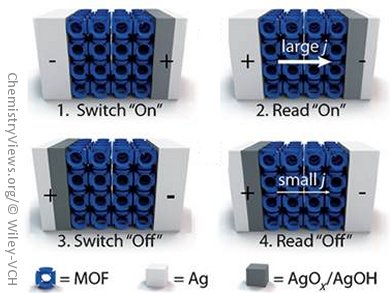American researchers have shown how cyclodextrin(CD)-containing metal–organic frameworks (MOFs) can act as memory elements that can be read, erased, and re-written. Bartosz A. Grzybowski and his team, Northwestern University, Evanston, studied a γ-CD-based MOF infused with Rb(OH)2 with silver or gold electrical contacts painted onto the faces of the crystals.
The MOFs can be switched between high and low conductivity states that remain even when the applied voltage is removed, which is characteristic of so-called “memristors”. The memristance was found to be dependent on both ion concentration and water content, which implied that ion movement is required for the phenomenon to occur.
Detailed studies into the mechanism showed that passivating oxide layers of nanometer thickness are deposited at the silver anode. The MOF channels allow the movement of OH– ions but limits that of hydrated Ag+ ions that come from the electrode. The MOFs were then used as memory devices by switching to a conductive “on” state by scanning the voltage from 0 to –10 V, which resulted in the oxidation of the right-hand electrode and the reduction of the left-hand electrode. This “on” state was “read” by applying a positive current between 2–4 V, and the device was switched to the “off” state by scanning to 10 V, which resulted in the reduction of the right-hand electrode and oxidation of the left-hand electrode.
These memory devices have great potential as they can be miniaturized and are ideal for high-density data storage. However their read/write times are still slow compared to other memristors although the researchers have already identified ways of making them faster.
- Storage of Electrical Information in Metal-Organic-Framework Memristors,
Seok Min Yoon, Scott C. Warren, Bartosz A. Grzybowski,
Angew. Chem. Int. Ed. 2014.
DOI: 10.1002/anie.201309642




